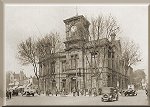|
|
 |

Click to return to front page |
By Frank Sharman
INTRODUCTION AND CONTENTS
This is a brief history of Bilston to 1800 with only brief notes for the period after that. You can follow the story in sequence by starting on the first page listed below and then clicking on the button at the foot of each page; or dip into it from any of the links below.
1. Bilston before the Norman Conquest
2. Bilston after the Norman Conquest
3. Early industrial development up to about 1790
Notes on sources and acknowledgments:
This outline history of Bilston is largely based on G. T. Lawley’s “History of Bilston”, 1893, up to the beginning of the 19th century. Account is also taken of John M. Price’s “The Story of Bilston”, 1951; and Frances Taylor Page’s “The Historical Background to Black Country Industry”, on the Black Country Memories Club web site. Both Price and Page rely heavily on Lawley. Much use has also been made of Marie B. Rowlands, “Industry and Social Change in Staffordshire 1660-1760”, Transactions of the Lichfield and South Staffordshire Archaeological and Historical Society, Volume 9, pp.37-58, which is the most scholarly of these sources, dependant on original documents. I have also read Joseph Price, “An Historical Account of Bilston …. etc. etc. etc.” 1835, which is almost exclusively concerned with the church and the local landowners. It contends with numerous contemporary volumes of collected sermons for being the most boring book ever written. But bits of useful information can be gleaned within it.
Lawley was an enthusiastic Victorian amateur historian and his work shows many of the signs of this context, with its emphasis on the medieval land owning families and the history of the church. But it does also contain chapters on the industrial development of the town, not a common feature of Victorian histories. It should also be noted that Lawley quotes from documents in the Wrotteseley family archive, which was destroyed by fire not long after he wrote. His book therefore remains a valuable source for these documents – indeed the only one.
The history given here is avowedly an outline. It is an attempt to produce a history in which the balance is more towards matters of interest to-day; and which provides something of a structure which, it is hoped, is more coherent than Lawley's and more suitable for expansion as and when time serves.
My thanks to Reg Aston for checking the first draft.
Where is “Bilston”?
For the purposes of this history Bilston is taken to be, roughly, the area of the old Bilston Borough Council up until 1966. It therefore includes Bradley which was a separate manor but seems always to have seen Bilston as its local centre. The area includes part of the old manor of Sedgley, mainly the part known as Ettingshall.
It will be noted that although Bilston (with Bradley) had and has a separate identity, the people of Bilston looked to Wolverhampton when they needed a large centre, rather than to Dudley or Walsall. People from both Bilston and Wolverhampton owned land and, later, businesses in the other town and were, to some extent, concerned with the affairs of the other town. There was thus some community of interest between the two places and, it seems,realtively little between those two places and other centres within the area. This situation probably arose because of proximity and the line of transport routes but also because Bilston was originally part of the Parish of St. Peter’s, Wolverhampton. But it will be noted that the story of this important aspect of governance is one of St. Leonard’s, Bilston, constantly trying to assert its independence of St. Peter’s, Wolverhampton – and eventually succeeding.
 |
 |
| Back to History Index | Before The Conquest |